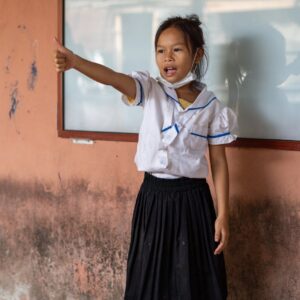Beyond the profound disruption it has caused to education systems, the COVID-19 pandemic also risks causing a significant increase in child labor as families’ livelihoods decline in middle and low-income countries. This is the case of Chana* and Ley*, two Cambodian children, aged 12 and 9, pushed into working when schools closed to help their family survive.
Since 2000, the number of child laborers in the world has fallen by 94 million; an achievement which is today threatened. Indeed, according to the International Labor Organization (ILO) and UNICEF, COVID-19 could lead millions more children to work. This is already the case in Cambodia, where young people often have to contribute to the income of their families living below the breadline.
Living conditions worse than anything
In Phnom Penh, the Cambodian capital, many families were already in a situation of poverty before the pandemic. Today their living conditions are worse than before. With parents losing their jobs due to the crisis and children no longer able to benefit from school meals due to school closures, it is sometimes difficult to survive on a daily basis.
That’s why Chana, 12, and her friend, Ley, 9, both went to work. During school closures, they walked the streets of their neighborhood to collect plastic and recyclable waste to try to make an income from it. Sometimes they devoted a whole day to it, sometimes only in the evening or night when it was less hot.
A real matter of survival
However, the Convention on the Rights of the Child enshrines the right of the child to be protected against economic exploitation and not to be required to perform work involving risks or likely to jeopardize their education or harm their health or their physical, mental, spiritual, moral or social development. But in this extreme context, the work of the whole family can be a real matter of survival.
Several studies show that a one percentage point increase in poverty leads to an increase of at least 0.7 percent in child labor. An adaptation mechanism as unfortunate as it is necessary.
These two children, however, were hopeful that their situation would not last and that they could return to school as soon as possible. While many schools reopened in Cambodia in September, children in this area were only attending approximately one hour a day due to classroom size restrictions imposed by Covid prevention measures. Now, since early November, schools in the country’s capital are closed. As education continues to be disrupted, the hope of Chana and Ley appears rather slim since child labor is often synonymous with dropping out of school.
Under The Cambodian Consortium for Out of School Children, in partnership with Educate a Child, a global programme of the Education Above All Foundation, we will continue to support children like Chana and Ley to access education. Our aim is to enroll over 118,000 out of school children in school over the next four years. While schools remain closed, we will continue our emergency response efforts, distributing food, hygiene kits and school materials to those who need them most.






